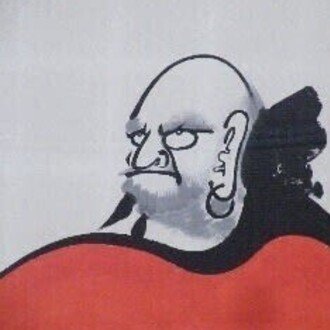
文盲の方とって、「絵心経」は御仏の慈悲そのもの。 For those who are illiterate, "Painting Sutra" is the mercy of the Buddha.
和紙に13仏と鳳凰、そして般若心経を添えた13仏曼荼羅制作にかける創造力やチャレンジ性には驚かされる。その方の他の作品がまた驚く。ご覧の通り大日如来像を中心に、その下にいま風の絵文字のようなものが描かれている。
I am amazed at the creativity and the challenging nature of the 13 Buddha Mandala productions in which 13 Buddhas are put on a paper with a phoenix and Hannya Sutra. The other works of that person are surprised again. As you can see, the Dainichi Nyorai statue is centered around it, and below it is a pictograph of the modern style.
実は、これが「絵心経」といわれるものである。江戸時代に字が読めなかった人たちのために般若心経の文字を絵で表現したものである。それを見ると、当時の庶民が使う日常のモノを絵にしている。それがユーモラスに表現されているのに驚かされる。
In fact, this is what is called the "Painting Sutra". For people who could not read in the Edo era, this is a pictorial representation of the letters of the Hannya Shinkyo. When you look at it, it depicts the everyday objects used by the common people of the time. I am surprised that it is expressed in humor.
例えば、摩訶般若波羅蜜多心経の出だしの「摩訶」は釜を逆さに描いて"まか"と読ませている。「般若」は"般若の面"、「波羅」は"腹"、「蜜」は"箕(農具)"、「多」は"田んぼ"、「心経」は"神鏡"などお絵描き、言葉あそびのように様々な楽しい工夫がされている。文盲の方たちが御仏の慈悲にすがるために、この「絵心経」が広まり親しまれたようである。
For example, “Maka”, which is the beginning of the story of Maka nannya haramitsuta shingyo, is drawn with the kettle upside down and read as “maka”. "Hannya" is "Hannya no Men", "Hara" is "belly", "Mitsu" is "mino (farm implement)", "Ta" is "rice pad", "Shingyo" is "Kami no kagami", and so on. There are various fun ideas like playing with words. It seems that this "paintig sutra" spread and became popular as illiterate people entrusted to the mercy of the Buddha.

一連の作品を描いている方は、教室ではあまり作業をされない。何を描いていいかわからないから、と。和紙と題材を提供し、その方の自主性に任せている。実に見事なものを描いて持参される。因みに70代の半ばの女性である。
Those who draw a series of works do not work much in the classroom. She said that I don't know what to draw. We provide Japanese paper and materials and leave it to that person's autonomy. You will be drawn with something truly beautiful and brought. By the way, she is a mid-70s woman.
お一人お一人の個性が発揮され、自分の暮らしに “感謝” や “目標” “喜び” が生まれてくるなら嬉しい限りである。
It would be great if each person could exercise their individuality and create “gratitude”, “goals” and “joy” in their lives.
レポート & 写真 / 渡邉雄二 仏画 & 絵文字制作 / 神戸教室の生徒さん
Reported & Photos by Yuji Watanabe Painting sutra by student
いいなと思ったら応援しよう!

